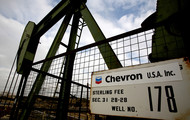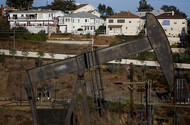California Fracking Fight Has $25 Billion Taxes at Stake
California (CROMCA)’s reputation for environmental protection may be jeopardized by the lure of a $25 billion tax windfall that depends on how the state permits oil companies to take advantage of vast deposits lying two miles beneath its golden hills.
The Monterey Shale formation running through the center of the state may hold 15.4 billion barrels of oil -- equivalent to five years of U.S. petroleum imports, according to a state report. Releasing it requires drillers to smash the rock by forcing millions of gallons of water and chemicals underground, a technique known as fracking.
While New York and others have moratoriums on fracking as potential pollution risks are assessed, California -- the fourth-largest oil-producing state -- is working on industry- backed standards that allow it. With fracking, the Monterey Shale may yield 2.8 million jobs and $24.6 billion in state and local taxes by 2020, the University of Southern California said last week.
“The industry has been able to use hydraulic fracturing safely and in an environmentally responsible fashion in order to generate significant oil and gas resources,” said Kurt Glaubitz, a spokesman for San Ramon, California-based Chevron Corp. (CVX), among the state’s biggest employers.
The Monterey Shale, running southeast of San Francisco at an average depth of 11,000 feet, extends over about 1,750 square miles and may hold 64 percent of the nation’s estimated shale oil reserves, according to the federal Energy Information Administration. That’s double the combined reserves of the Bakken Shale (NDBOOILP) in North Dakota and the Eagle Ford Shale in Texas, where energy companies are spending billions.
New Guidelines
California’s environmental laws put limits on development, require a unique blend of gasoline to reduce smog and will impose a statewide cap on greenhouse-gas emissions. Yet the state is only now developing specific guidelines for hydraulic fracturing, as the method is known.
The state Conservation Department in December released an initial proposal of fracking regulations, including rules for storing and handling fracking fluids, well monitoring after fracking and preventing water contamination.
A form of fracking has been used in California for 60 years, said Tupper Hull, a spokesman for the Sacramento-based Western States Petroleum Association, an industry trade group. About 750 of the roughly 50,000 producing oil and gas wells in the state use fracking, according to data from FracFocus.org, a registry set up by the industry, and the National Resources Defense Council.
Tapping Reserves
For decades, the U.S. Environmental Protection Agency “and every state considered hydraulic fracturing as a routine well- stimulation technique,” said Jason Marshall, the chief deputy director of the state Conservation Department. With the rise of advances in fracking and horizontal drilling, tapping oil shale reserves became feasible.
“Public concerns began coming to us about the use of the practice,” Marshall said. “The concerns seem to arise from the absence of good information about the when, where and how of fracking operations.”
Residents and environmentalists such as the Sierra Club and the Center for Biological Diversity -- which sued the state in January for allegedly failing to regulate fracking -- dominated the first five hours of a six-hour state hearing in Bakersfield last week on the proposed rules.
Marianne Ratcliff, who lives near oil wells in the Upper Ojai Valley, called for tougher regulations, saying companies would absorb a proposed $25,000-per-violation penalty as a cost of doing business. She said state regulators, rather than the oil companies themselves, should monitor the chemicals used in the fracturing process.
Locked Gates
“It’s very unlikely they would be noticed, since they are behind locked gates in the hills,” Ratcliff said.
Representatives of oil companies including Chevron and Los Angeles-based Occidental Petroleum Corp. (OXY), the largest oil producer in the continental U.S., said they backed the Conservation Department’s draft proposal.
“We think it’s an appropriate framework to provide people the confidence that oil is produced prudently and safely and under stringent oversight by the state of California,” said Hull, a spokesman for the Western States trade group.
Oil company representatives at the Bakersfield hearing made a case for fracking as part of California’s economic future. Producers believe in “environmental integrity,” said Nick Ortiz, manager of production regions and property-tax issues for Western States.
Not Tracked
Under current laws, oil and gas operators aren’t required to report the details of their fracking operations. Identifying fracking’s consequences in California is difficult because the state hasn’t tracked where it’s used and ground-water testing before or afterward isn’t required, said Andrew Grinberg, an oil and gas program coordinator in the Oakland office of Clean Water Action, an environmental group.
“So if you’re not looking for a problem, it’s pretty hard to find it,” Grinberg said.
The proposed restrictions are “ totally inadequate for protecting public health and the environment,” he said. “It does not require any groundwater monitoring, it does not have any safeguards in place for air quality, it does not even require positive approval or a permit from the state to move forward with fracking. So we want to see it beefed up big time.”
The drilling process has been linked to groundwater contamination in Pennsylvania, high ozone levels in Wyoming and to headaches, sore throats and difficulty breathing for people living close to wells in Colorado.
Earthquake-Prone
Another concern in California is whether deep underground wells used by the industry to dispose of fracking wastewater can trigger earthquakes. The famous 1906 earthquake in San Francisco that killed as many as 5,000 people and set off fires that razed most of the city was one of the worst natural disasters in U.S. history.
Twelve earthquakes centered within a mile (1.6 kilometers) of an injection well in Youngstown, Ohio, have been linked to wastewater fracking activities, according to a state report that led to new regulations.
Besides New York, North Carolina and New Jersey have established fracking moratoriums, and Vermont has banned the practice, according to a report in February to California lawmakers.
California Governor Jerry Brown, a 74-year-old Democrat, and legislators have “made it very clear to the department that there is a need for regulations specific to hydraulic fracturing,” said Marshall of the Conservation Department.
Brown Defers
Brown told reporters in San Francisco on March 13 that he is deferring to state regulators to develop a fracking policy.
“Between now and development lies a lot of questions that need to be answered, and I feel confident that the people are in place in my administration to handle the issues as they come up,” Brown said at a news briefing on renewable energy.
The issue is also being considered at the federal level. At the request of Congress, the EPA is studying fracking’s impact on drinking water and will release its findings next year.
Water is an issue in California because some areas of the state have outgrown their supply. Brown is pressing for a $14 billion tunnel system to serve arid Southern California. Parts of Monterey County already face restrictions with a water credit system. Remodeling a bathroom and replacing a large bathtub with a smaller one, for instance, can free enough water credits to offset an additional washbasin.
Five bills are pending in the state Legislature that touch on fracking, including one that would require drillers to provide details about the chemicals and amount of water to be used and to notify neighboring property owners in advance.
‘Immense Scale’
“While the industry correctly notes that fracking has been going on in California for 60 years, many of the techniques and chemicals are new, as is the immense scale of many of these operations,” said state Senator Fran Pavley, a Democrat from Agoura Hills, the chairman of the Senate Natural Resources and Water Committee and the bill’s author.
Her bill also directs the state to complete a study by Jan. 1, 2015, assessing the public and environmental health and safety of fracking, and would deny new fracking permits if the study is not finished in time.
Other bills would also require companies to disclose the chemicals used in fracking, to file a written notice at least 30 days before any fracking operations and to monitor ground water near their operations.
In Kern County, which produces more than 80 percent of California’s oil and gas, about 600 of its 50,000 active oil wells are hydraulically fractured each year, said Lorelei Oviatt, director of the county planning department.
“We don’t have any evidence that there’s impact on ground water from hydraulic fracturing in Kern County,” Oviatt said in a telephone interview. “I don’t want to leap to conclusions that will put 15,000 to 20,000 people out of work.”
To contact the reporter on this story: Alison Vekshin in San Francisco at avekshin@bloomberg.net
To contact the editor responsible for this story: Stephen Merelman at smerelman@bloomberg.net
©2013 BLOOMBERG L.P. ALL RIGHTS RESERVED.

